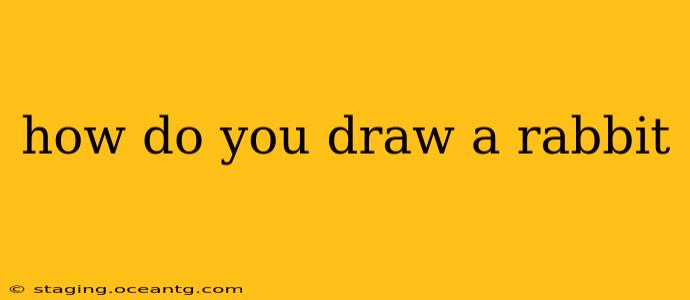How to Draw a Rabbit: A Step-by-Step Guide for Beginners and Beyond
Drawing a rabbit can be a fun and rewarding experience, whether you're a seasoned artist or just starting out. This guide will walk you through several methods, from simple to more detailed, helping you create adorable and realistic rabbit drawings.
Understanding Rabbit Anatomy: Before we begin, understanding some basic rabbit anatomy will greatly improve your drawing. Note the shape of the head (roundish with long ears), the fluffy tail, and the placement of the eyes, nose, and mouth. Observing real-life photos or videos can be incredibly helpful.
Method 1: The Simple, Cartoonish Rabbit
This method is perfect for beginners or for quickly sketching a cute rabbit.
- Start with a circle: Draw a slightly elongated circle for the head.
- Add the ears: Draw two long, oval shapes on top of the circle, slightly angled outwards.
- The body: Below the head, draw a smaller, slightly elongated oval for the body. Connect it to the head with a slightly curved line for the neck.
- Legs and feet: Add four small ovals for the legs, two beneath the body and two just behind it slightly to the side. Add smaller ovals for the feet at the end of each leg.
- Facial features: Draw two small, round eyes, a tiny nose, and a small, curved mouth.
- The tail: Add a small, fluffy puff of a tail at the end of the body.
- Details: Add some lines to define the fur, and erase any unnecessary guidelines. You can add whiskers too!
Method 2: A More Realistic Rabbit
This method requires a little more attention to detail but results in a more lifelike rabbit.
- Head construction: Start with a circle for the head, then lightly sketch a guideline down the center. Add construction lines to indicate the placement of the eyes, nose, and mouth.
- Ear construction: Draw the ears as elongated triangles, remembering that they are quite large relative to the head.
- Body construction: Sketch a rounded shape for the body, connecting it smoothly to the head. Think about the rabbit's posture - are they sitting, standing, or hopping?
- Leg and foot construction: Draw the legs as slightly curved cylinders, and add small ovals for the feet at the ends. Note the position and shape of the feet will change based on the rabbit's pose.
- Facial features: Carefully draw in the eyes, nose (a small triangle is a good starting point), and mouth. Rabbits have quite expressive noses!
- Fur details: Use short, light strokes to create the texture of the fur. Vary the length and direction of your strokes to give it depth and realism.
- Refine the lines: Go over your sketch with darker lines to define the rabbit’s form. Erase unnecessary construction lines.
How do you draw a rabbit's fur?
Creating realistic-looking fur involves using short, light strokes to suggest the direction and texture of the fur. Vary the length and pressure of your strokes to create depth and shading. Pay attention to the direction of the fur growth – it usually flows downwards. You can use hatching and cross-hatching techniques for darker areas.
How do you draw a bunny's face?
A bunny's face is characterized by its large, expressive eyes, a small, triangular nose, and a tiny mouth. The eyes should be slightly oval, with dark pupils. The nose is usually positioned centrally between the eyes. The mouth is small and often slightly curved. Don’t forget the whiskers!
What are some different poses to draw a rabbit in?
You can draw a rabbit in many poses. Some popular options include:
- Sitting: A relaxed and common pose, ideal for showing off the rabbit's fluffy tail.
- Standing: Shows off the rabbit's legs and body proportions.
- Hopping: A dynamic pose that captures the rabbit's agility.
- Eating: Adding a carrot adds a nice touch.
- Sleeping: A curled-up position.
Remember to practice! The more you draw, the better you'll become at capturing the unique features and charm of a rabbit. Experiment with different styles and techniques to find your own approach. Have fun!
